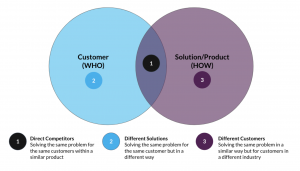Undertaking a competitive analysis is often one of the most overlooked research methods available in an optimisation teams’ arsenal. This method gives you the tools to benchmark your company against others within your industry, allowing you to become aware of upcoming trends your competitors might already be leveraging.
A thorough analysis can help you identify weaknesses with your own website and even help you find ways for reducing these issues. You might even identify competitor strengths that help inspire your own future optimisation ideas and designs. But how do you go about performing a competitor analysis? At CCX we look to follow just three simple steps, which are outlined later on in this post.
Why should you invest time and resources into conducting a competitor analysis?
Without taking the time to check out your competitors, it’s almost impossible to benchmark your performance and user experience against companies within your industry, or those you aspire to be like. Failure to acknowledge the competitor will leave you in a complacent bubble, perhaps giving competitors the time required to overtake you. Although, ultimately, we believe our customers should be aiming to be the leaders within their industry, another reasoning behind not focusing too much on your competitors or copying them.
How should you perform competitor research?
It’s important to note that your customers are not the same as your competitor’s customers, so you should never look at your competitor’s website and consider it gospel. Replicating a competitor’s website design simple because you came across it in your reach is usually a bad idea. You also can’t see the impact their website is having on their users, so you might end up copying a feature of their site that resonates poorly with users anyways!
Instead, your competitor analysis should be used in conjunction with other sources of data.
At CreativeCX, we typically perform competitor analyses for our clients once we’ve already gathered initial insights on how our client’s websites are performing and how their customers behave while engaging with the site. This helps us identify any problems their customers might be facing. We then use this information to conduct a competitor analysis, taking a close look at some of the possible ways the competitor is overcoming issues we have identified in the review step.
The three steps to effectively analyse the competition
We break down each competitor analysis into three simple steps:
- Identify the direct or indirect competitors you want to analyse
- Define the criteria for your market research
- Turn your results into optimisation themes
1. Identify your direct and indirect competitors
You probably already have some brands in mind that you view as your key competitors. These competitors often operate in your industry. But even if you’ve previously identified your main competitors, don’t skip this step: identify your competitors again! After all, the industry might have changed since you previously made your enemy list. You might find that you’re facing new challenges – or your old foes have changed their offerings.
Direct competitors are likely to have a similar product, value offering and customer base, so it’s important to understand what their strengths and weaknesses are and how they differ from your own company.
It’s up to you whether you include indirect competitors. These tend to be businesses that don’t operate within your industry but are loosely connected to your company. For example, if you have an online credit card business, you may pick a competitor in the insurance sector. Whilst these businesses aren’t directly related to one another, both companies are likely to face the same hurdles. For example, customers in both would have to fill long forms or pick a product they need with limited knowledge. Additionally, both companies work in heavily regulated industries.
By adding these sort of indirect competitors, you could gain surprisingly innovative insights into how businesses in different industries manage to overcome some of the issues you’re facing.
Your indirect competitor list may also include aspirational businesses that aren’t connected to your own company at all. This is, of course, a valid source of inspiration especially when you’re making changes to improve your customer experience.
A handy way of visualising your competitors is using Myk Pono’s Classification:

2. Define your criteria
There are a number of competitor analyses you could run, which is why it is important to define your objectives beforehand. This allows you to understand the type of criteria you should be focusing on for your analysis.
At CreativeCX, as we have already gathered initial insights into our client’s website and customers, our competitor analysis typically focuses on the main customer journeys, particular product features, or persuasive methods.
Customer Journeys
For this we either look at the overarching customer journey as a whole or a specific part of the journey for our customers, depending on what our own analysis has told us about how our client’s offerings need to be improved.
We may choose this when we want to focus on UX. For example, this could be the identification of how other competitors deal with any pain points we’ve already identified in our research.
Particular features or methods
This is where we look at particular features or methods that competitors have used to solve their customer problems. These features may look at different aspects of the website, like the way competitors use trust signals and social proofing, or methods for cross-selling and upselling.
The key here is to identify what insights you are trying to gain from this competitor analysis and conduct the research in such a way that you’re able to achieve this. The last thing you want to do is perform a competitor analysis with little preparation as this will result in research that is unfocused and disorganised.
3. Use results to address customer problems
As we’ve previously mentioned, it is very important to remember that your customers are not your competitor’s customers. You may have previously encountered the scenario of being told to change your website in a certain way because “that’s what so-and-so do on their website”, but this is not a valid reason as the problems your competitor’s customers face won’t be the same as the problems your own customers have. If you’ve already formulated your customer problem statements, these can also be good to bear in mind while you’re conducting your competitor analysis, especially when you’re researching indirect competitors that face similar hurdles to you.
From here, you can start to feed your insights into the natural test-and-learn cycle. Again, now is a great time to draw inspiration from competitors when coming up with designs – but only if what they’ve done is suitable for your own customers.
Whether you want to gain more insights into how we work or you want us to help you with your own competitor analysis, get in touch with us via our contact form.



